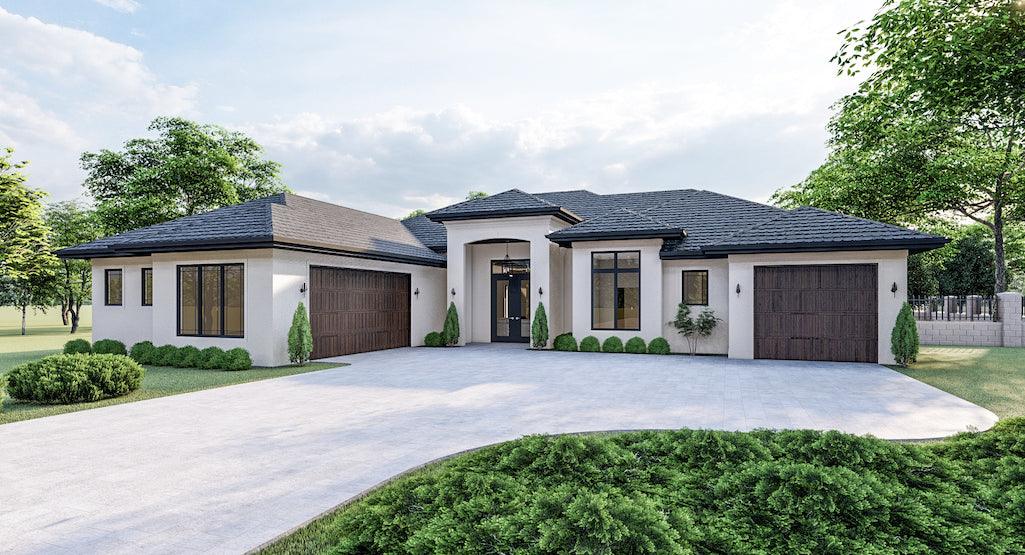Mediterranean-style homes are a popular choice among homeowners and buyers, known for their sophistication, warmth, luxury and a timeless appeal. The reason why they are so popular is because of their classy architectural details such as arched entryways, stucco walls, exposed beams, and ironwork. These homes are often built for coastal views and moderate climates, encouraging outdoor living. If you are in the market for a Mediterranean house plan, then here are some must-have features that give it the characteristic look.
Arches
Arches and arched entryways have been a signature element of Mediterranean architecture since the Roman era. Apart from their ornamental value, arches can support heavy loads, making them ideal for building large, open spaces in Mediterranean homes. Moreover, arches added a sense of elegance and charm to Mediterranean architecture, creating a sense of flow and openness within the home.
Stucco Walls
Perhaps the most recognizable element of Mediterranean house designs is the stucco finishes. Stucco is a cement based plaster that hardens on drying to create an uneven texture. The stucco walls protect the exterior from strong sunlight, heavy downpours and spiking temperatures, all common to the Mediterranean climate.
Red tiled roofs
The landscape of Southern Europe is filled with homes that are adorned with red tiled roofs. These red tiled roofs are generally made of terracotta recreating the same rustic charm alongside benefits such as sustainability and insulation. The contrast between the terracotta roofs and the stucco exteriors create a uniquely beautiful look in Mediterranean homes. One is instantly reminded of the warmth and allure of Mediterranean architecture whether it is coastal villas or modern homes. Red tiled roofs remain an integral part of this design imparting the homes with a distinct appeal.
Courtyards and Patios
The Mediterranean style of architecture focuses heavily on creating oneness with nature. So, there is much emphasis on outdoor spaces like courtyards and patios for the homeowners to unwind and soak in the outdoors beauty. Often, Mediterranean homes feature outdoor kitchens or grilling areas, allowing residents to experience al fresco dining.
Stone and Terracotta flooring
Both stone or terracotta flooring remain a popular choice for Mediterranean house plans. These are classic options that add a natural and rustic vibe to the interiors. Additionally, the earthy colors and slightly textured surfaces give the homes an unmissable charm and inviting feel. Terracotta flooring is also durable and easy to maintain.
Symmetry
Mediterranean homes boast a symmetrical appearance creating a sense of harmony and order. Symmetry is an essential part of Mediterranean architecture. The house layout and floor plan achieves this by creating facades, courtyards, and landscaping that is symmetrical. The front of the house has symmetrical elements such as matching windows, doors, and columns. Arched doorways and windows, central courtyards, and balanced layouts further create this sense of balance.
Exposed beams
Made from wood, exposed beams are used heavily in Mediterranean homes. They may be left in their natural state or stained in earthy tones that align with the overall look of the Mediterranean design. The contrast of exposed beams with stucco walls and tiled floors creates a welcoming atmosphere in the house. Exposed beams also highlight the art and craft of Mediterranean workmanship that combine form with function.
Wrought Iron
Wrought iron is another key feature in Mediterranean house plans, often seen in elements like window grilles, balconies, railings etc. The rich ironwork adds old world charm and elegance to the home also reflecting the craftsmanship of the Mediterranean region. Ironwork not only looks aesthetically appealing but also adds to the overall character of the Mediterranean style architecture.
Open Floor Plan
An open floor plan adds a modern touch to Mediterranean house designs and is commonly seen in most contemporary house plans. The layout combines the kitchen, dining and living areas into one large, connected space to enhance the flow of natural light and promote a sense of openness. The open floor plan sometimes opens into outdoor living areas like courtyards and patios creating an easy transition between the indoor and outdoor spaces. Open floor plans not only optimize space but also create a warm, inviting atmosphere perfect for family living and entertaining.
Vibrant Hues and Mediterranean Materials
Mediterranean homes are known for their vibrant yet earthy tones that represent the natural beauty of the region. You will often find bright, bold colors like warm terracotta, reminiscent of sunbaked clay and deep olive green similar to the verdant landscape or a deep blue inspired by the sea. The palette complements the natural materials used in the design. Additionally, natural materials like stone, wood, and terracotta are used extensively in the house design to bring out the home’s connection with the environment. Stone is used in flooring, fireplaces, and exterior walls, wood is used in beams, doors and cabinetry while ceramic tiles are used for backsplashes and flooring.
Conclusion
Mediterranean homes focus on a balance between indoor and outdoor living with spacious, open plans, along with the material and colors found in Spanish and Italian architectural design. You can combine all or some of these features to build your dream Mediterranean house.

































